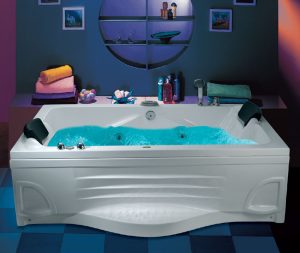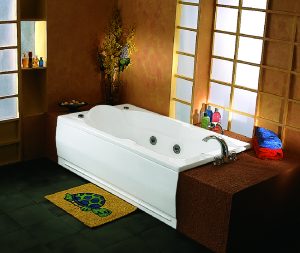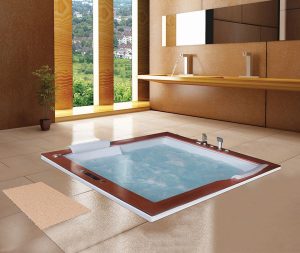When it comes to designing or renovating your bathroom, one of the most important decisions you’ll make is choosing the right bathtub. The type of tub you select can have a big impact on the overall look, feel, and functionality of your space. Two popular options are corner bathtubs and standard tubs. Both have their own unique advantages and considerations, and the right choice for you will depend on your specific needs and preferences.
In this blog post, we’ll take a closer look at corner bathtubs and standard tubs. We’ll explore their defining characteristics, benefits, and potential drawbacks. By the end, you’ll have a better idea of which type of tub might be the best fit for your bathroom.
Corner Bathtubs
Corner bathtubs are a stylish and space-saving option for many bathrooms. As the name suggests, these tubs are designed to fit snugly into the corner of a room. They typically feature a triangular or rounded shape that makes the most of available space.
One of the biggest advantages of corner tubs is their ability to maximize space efficiency. If you have a smaller bathroom or an awkwardly shaped layout, a corner tub can be a great way to add a luxurious bathing experience without sacrificing too much floor space. Corner tubs also offer a unique and modern look that can serve as a stunning focal point in your bathroom design.
In addition to their space-saving properties, corner tubs often provide a more comfortable bathing experience compared to standard tubs. Their unique shape allows for more room to stretch out and relax, and many models come with built-in seats or backrests for added comfort.
However, there are a few considerations to keep in mind when it comes to corner tubs. Installation can be more complex than with standard tubs, as the tub may require special plumbing and structural support. Corner tubs can also be less accessible for some users, particularly those with limited mobility, as the tub’s shape may make it more difficult to enter and exit.
Corner tubs tend to be more expensive than standard tubs due to their specialized design and installation requirements. But for many homeowners, the space-saving benefits and unique aesthetic of a corner tub are well worth the investment.
Standard Bathtubs
Standard bathtubs are the most common type of tub found in homes today. They are rectangular in shape and typically sit along one wall of the bathroom. Standard tubs come in a range of sizes, with the most common being 60 inches long and 30 to 32 inches wide.
One of the main benefits of standard tubs is their widespread availability and affordability. Because they are so common, standard tubs are readily available from a variety of manufacturers and retailers. This can make it easier to find a tub that fits your budget and style preferences.
Standard tubs are also easier to install than corner tubs in most cases. They have a simple, rectangular shape that fits well in a variety of bathroom layouts. This can make them a good choice for homeowners who want to update their bathroom without major renovations.
Another advantage of standard tubs is their accessibility. The straight sides of a standard tub make it easier for most people to get in and out, which can be important for families with young children or individuals with mobility issues.
However, standard tubs do have some limitations. They require more floor space than corner tubs, which can be a challenge in smaller bathrooms. Standard tubs also offer fewer design options compared to the unique shape of corner tubs.
Factors to Consider
When deciding between a corner tub and a standard tub, there are several key factors to consider. The first is the available space in your bathroom. Carefully measure your bathroom and consider how each type of tub would fit into the layout. Keep in mind that corner tubs can help maximize space in smaller or irregularly shaped bathrooms, while standard tubs may be a better fit for larger bathrooms with a more traditional layout.
Accessibility is another important consideration. If you or someone in your household has limited mobility, a standard tub with straight sides may be easier to use than a corner tub with a more complex shape. Consider the needs of all potential users when making your decision.
Your design preferences will also play a role in choosing between a corner and standard tub. Corner tubs offer a distinctive, modern look that can add visual interest to your bathroom. Standard tubs, on the other hand, have a more classic appearance that can fit well with a variety of design styles.
Finally, it’s important to think about your budget. Corner tubs tend to be more expensive than standard tubs due to their specialized design and installation requirements. However, the space-saving benefits and unique look of a corner tub may be worth the extra cost for some homeowners. Consider your budget and priorities when weighing your options.
Installation and Maintenance
The installation process for corner and standard tubs can vary significantly. Corner tubs often require professional installation due to their unique shape and specialized plumbing requirements. In some cases, modifications to the bathroom layout may be necessary to accommodate the tub. It’s important to factor in these potential additional costs and complexities when considering a corner tub.
Standard tubs, on the other hand, are typically easier to install. Many homeowners with basic plumbing and DIY skills can successfully install a standard tub themselves. However, professional installation is still recommended to ensure proper fit and function.
In terms of maintenance, both corner and standard tubs require regular cleaning to keep them looking their best. Corner tubs may have more nooks and crannies that can collect dirt and grime, so they may require a bit more attention to detail when cleaning. Standard tubs have a simpler shape that can make cleaning a bit easier.
Real-World Examples and Inspiration
To help you visualize how corner and standard tubs can look in real bathrooms, let’s take a look at some inspiring examples.
Corner tubs can add a stunning focal point to a bathroom. In a smaller space, a corner tub can be paired with a sleek, minimalist design to create a modern and efficient look. In a larger bathroom, a corner tub can be surrounded by luxurious finishes like marble or tile to create a spa-like oasis.
Standard tubs, while more traditional, can still make a beautiful impact in a bathroom. A classic clawfoot tub can add vintage charm to a bathroom, while a sleek, modern standard tub can create a clean and contemporary feel. Pairing a standard tub with interesting tile work or unique fixtures can help elevate the look.
Conclusion
Choosing between a corner bathtub and a standard tub ultimately comes down to your personal needs, preferences, and bathroom layout. Corner tubs offer space-saving benefits and a unique, modern look, but they can be more complex to install and less accessible for some users. Standard tubs are widely available, affordable, and easy to install, but they require more floor space and offer fewer design options.
When making your decision, carefully consider the size and layout of your bathroom, the accessibility needs of potential users, your design preferences, and your budget. By weighing these factors, you’ll be able to choose the type of tub that best fits your needs and helps create the bathroom of your dreams.
Remember, your bathroom should be a space that you enjoy and that meets your practical needs. Whether you choose a corner tub, a standard tub, or another option entirely, the most important thing is that your new tub contributes to a bathroom that you love spending time in.




